Yakyu Inari Shrine
Five minutes on foot from Higashi‑Matsuyama Station in Saitama, Yakyu Inari Shrine dates back to 712 CE but is best known today as Japan’s “Baseball Shrine.” The shrine’s name, “Yakyū” (箭弓), is pronounced the same as the Japanese word for baseball (野球). That coincidence has turned this quiet Inari shrine into a pilgrimage site for Little Leaguers, Koshien hopefuls, and professional stars who come to pray for batting confidence, stingy ERAs, and injury‑free seasons.
Traditional fox statues and vermilion torii still frame the grounds, yet most visitors head straight to the baseball‑themed corners. Home‑plate‑shaped prayer boards, racks of bat and glove charms, and walls lined with signed plaques reveal decades of diamond devotion. Local high‑school teams stop for blessings on their way to regional qualifiers, and Saitama Seibu Lions players have been spotted tying wishes alongside weekend sandlot sluggers.
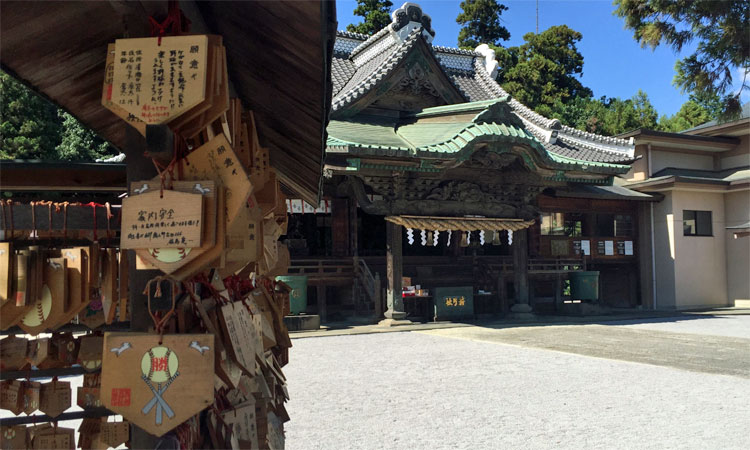
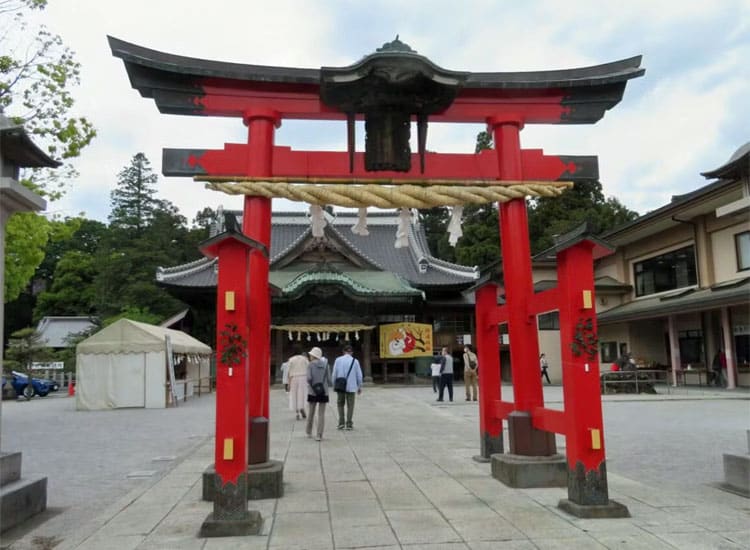
Home‑Plate & Bat Ema Racks
Just left of the main hall, two oversized wooden frames resemble a batter’s box. One is packed with home‑plate ema, the other with bat‑shaped plaques arranged like a neat dugout line‑up. Each board features hand‑drawn mascots, score predictions, and signatures. Coaches often bring entire rosters to hang matching plaques before tournaments, turning the racks into a living team photo and a snapshot of collective hope.
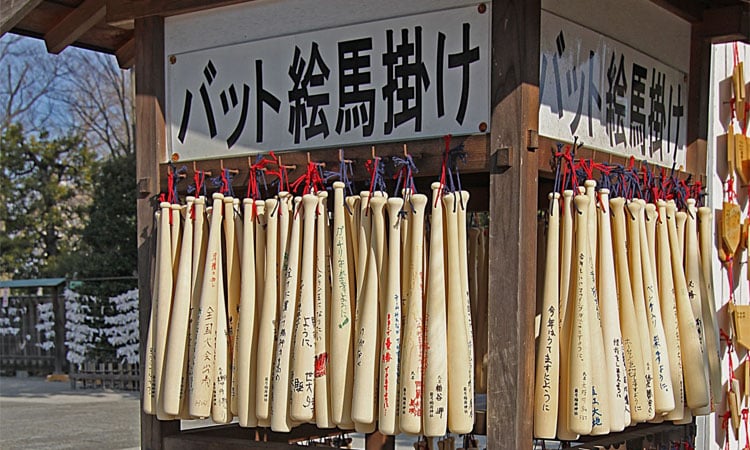
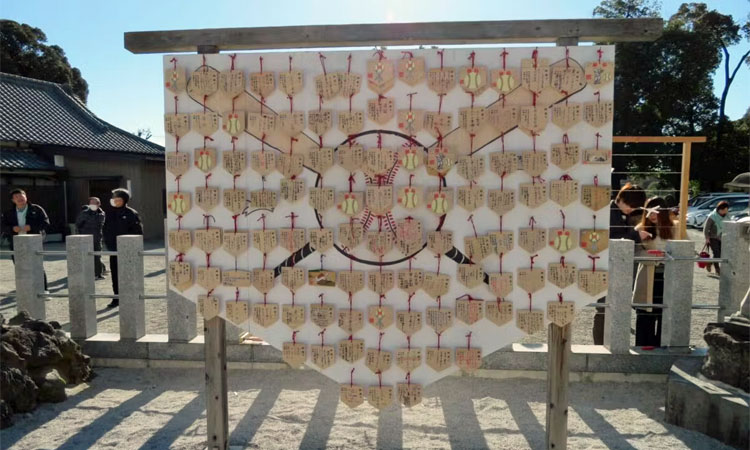
Baseball Prayer Plaques and Omamori
In front of the worship hall, a kiosk sells ema shaped like baseballs, bats, gloves, and home plates for about 800 yen each. Visitors jot wishes such as “Win Koshien” or “Hit .300” and hang the plaques on lattice racks that echo backstop fencing. The same kiosk offers portable omamori charms. A bat‑shaped charm slips into an equipment bag or bat sleeve, while a glove‑shaped charm clips to the strap of a fielder’s glove or gear bag so its blessing travels onto the field.
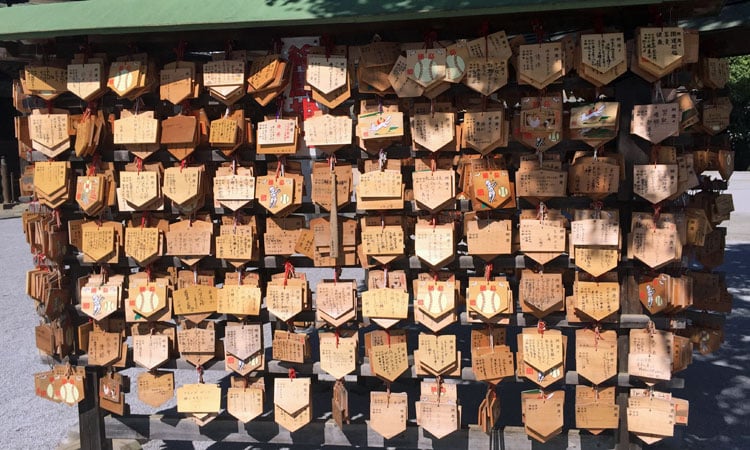

Pilgrimage of Pros & Teams
From the Saitama Seibu Lions to visiting NPB squads, professional players regularly bow at the cedar offering box before spring camps and pennant races. High‑school contenders add a stop here en route to Koshien, and Little League parents queue at season start to ask for sure‑handed gloves and lively bats. Inside the administration hall, signed baseballs, plaques, and newspaper clippings document decades of these pilgrimages, proving that even the greats welcome a little divine help between the lines.
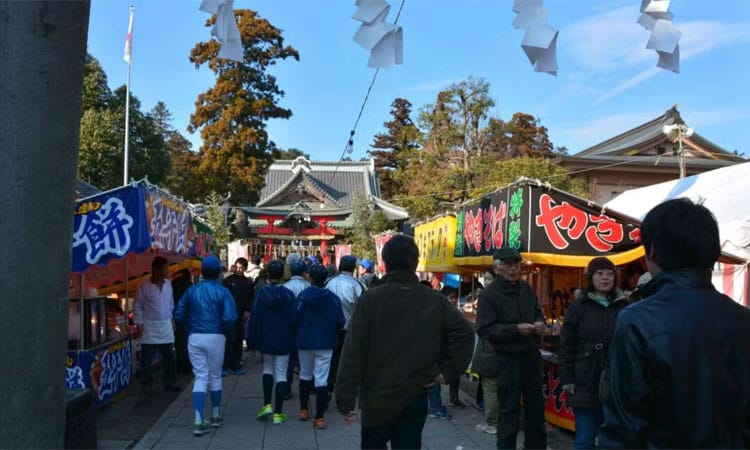
Tour Yakyu Inari Shrine
A stop at Yakyu Inari takes about 30–45 minutes and is free. From Higashi‑Matsuyama Station’s west exit, follow the bat‑shaped paving markers for roughly 400 metres to the torii‑lined entrance. After a quiet bow at the main hall, detour to the Guinness‑record 1.42‑metre wooden stamp, snap photos under the tunnel of vermilion gates, and look for the intertwined “married trees” that symbolize lasting unity.
Peony blooms in spring, wind‑chime canopies in summer, and lantern‑lit hatsumode crowds in early January provide seasonal touches. These events add fresh color throughout the year. Before leaving, pick up a goshuin stamp for your temple book and choose a baseball ema or omamori to carry the shrine’s blessings back onto the field.
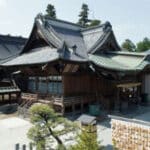
Explore U.S. and Canada baseball attractions:

Baseball Attractions
- Baseball Attractions
- USA:
- Babe Ruth Birthplace
- The Baseball Building
- Baseball Heritage Museum
- Baseballism
- Batcolumn
- Beyond the Vines
- Bob Feller Museum
- B-R-S Baseball Museum
- The Bobblehead Museum
- City of Baseball Museum
- College World Series
- Cooperstown Distillery
- Cooperstown, NY
- Deuce's Major League Bar
- Doubleday Field
- Field of Dreams
- Fogelman Sports Museum
- Harmon Killebrew HR Seat
- Heroes of Baseball Wax Museum
- Home Run Dugout
- Hot Springs Historic Baseball Trail
- Iowa Baseball Museum of Norway
- Irish American Baseball HOF
- Jackie Robinson Ballpark
- Jackie Robinson Museum
- Little League Museum
- Little League World Series
- Louisville Slugger Museum
- Mascot Hall of Fame
- Mets Hall of Fame & Museum
- Midnight Sun Game
- Monument Park
- Museum of Nebraska MLB
- National Ballpark Museum
- National Baseball Hall of Fame
- National Bobblehead Hall of Fame
- National Postage Museum
- Negro Leagues Baseball Museum
- Negro Southern League Museum
- North Carolina Baseball Museum
- Patrick Amiot Junk Art
- Rickwood Field
- Roberto Clemente Museum
- Roger Maris Museum
- Rookies Wiffle Ball Field
- Savannah Bananas
- Schrader's Little Cooperstown
- Shoeless Joe Jackson Museum
- Stadium Lofts at Bush Stadium
- Steelheads Alley
- Tampa Baseball Museum
- Ted Williams Museum
- Tony Gwynn Museum
- Ty Cobb Museum
- Yogi Berra Museum
-  
- Canada:
- Avenue of Champions
- Canadian Baseball HOF
- Saskatchewan Baseball HOF
-  
- Dominican Republic:
- Museum of the Dominican Player
-  
- Japan:
- Baseball Hall of Fame in Japan
- Koshien History Museum
- Matsui Hideki Baseball Museum
- Sadaharu Oh Museum
- Yakyu Inari Shrine
-  
- Mexico:
- Mexican Baseball HOF
-  
- Puerto Rico:
- Museo Francisco "Pancho" Coimbre
-  
- South Korea:
- Baseball Lighthouse
-  
- Taiwan:
- Baseball HOF & Fame Garden Hotel
-  
- Venezuela:
- Salon de la Fama Museo de Beisbol